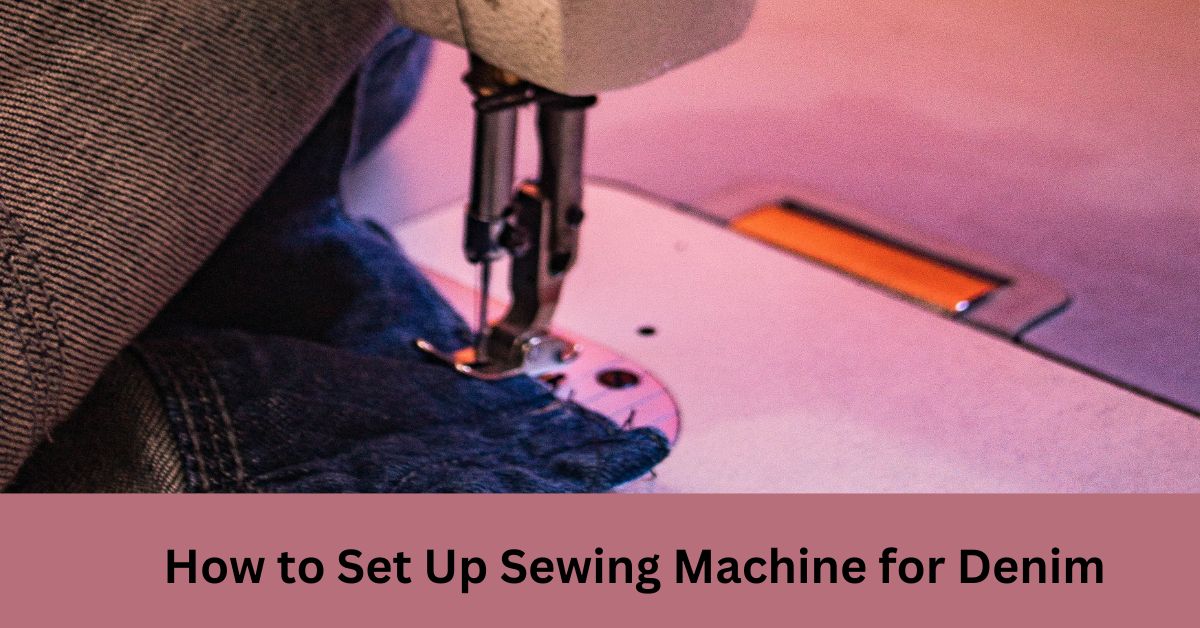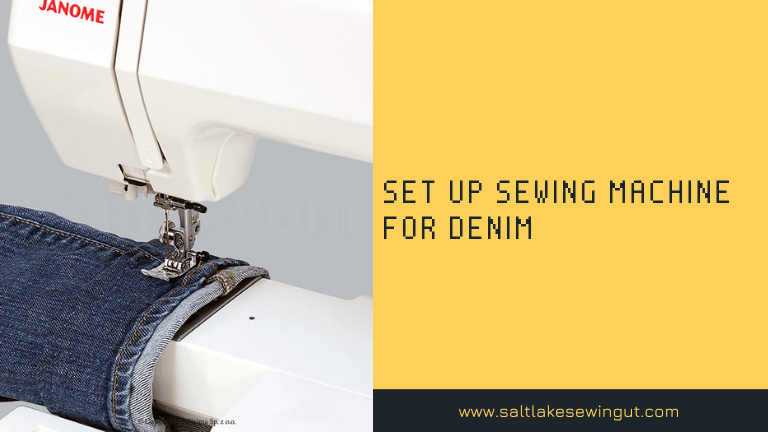Sewing Machine for Denim can be a bit of a challenge, especially if you’re new to sewing. The key to successfully sewing denim is having the right tools and setting up your sewing machine properly. In this article, we will guide you through the process of setting up your sewing machine for denim fabric. We’ll cover everything from selecting the right needle and thread to adjusting the tension and presser foot pressure. By the end of this article, you’ll have all the information you need to sew denim confidently on your sewing machine.

What setting do you use on a sewing machine for denim?
When sewing denim fabric, you’ll need to adjust the settings on your sewing machine to ensure that it can handle the thickness and weight of the fabric. Here are the recommended settings for sewing denim on a sewing machine:
- Needle
- Thread
- Tension
- Stitch Length
- Presser Foot Pressure
- Use a Walking Foot
Needle
Choose a sturdy needle specifically designed for denim, such as a denim or heavy-duty needle, in size 90/14 or 100/16, depending on the thickness of your denim.
Thread
Use a strong thread, such as polyester or cotton-wrapped polyester, for sewing denim. Avoid using lightweight threads as they may break easily.
Tension
Increase the tension on your sewing machine slightly higher than the normal setting to prevent the thread from bunching or breaking while sewing. Test the tension on a scrap piece of denim fabric before starting your project.
Stitch Length
Use a longer stitch length, such as 3.5-4mm, when sewing denim. This will prevent the fabric from puckering and make it easier to sew through multiple layers.
Presser Foot Pressure
Increase the presser foot pressure to help feed the thick denim fabric through the machine evenly. Consult your sewing machine manual for instructions on adjusting the presser foot pressure.
Use a Walking Foot
A walking foot is a special type of presser foot that helps feed thick or bulky fabrics through the sewing machine evenly. Consider using a walking foot when sewing denim.
By adjusting these settings, you’ll be able to sew denim fabric on your sewing machine with ease. Always test your settings on a scrap piece of fabric before starting your project to ensure you get the best results.
What tension should a sewing machine be for denim?
The tension on a sewing machine for denim should be slightly higher than the normal setting. Such as a denim or heavy-duty needle, in size 90/14 or 100/16, depending on the thickness of your denim.Top of Form
Can I sew denim on a regular sewing machine?
Yes, you can sew denim on a regular sewing machine, as long as you use the right needle and thread, and adjust the machine settings properly. Denim fabric is thicker and heavier than many other fabrics, so it’s important to choose a sturdy needle and thread and adjust the tension, stitch length, and presser foot pressure on your sewing machine to ensure it can handle the thickness of the fabric. Additionally, using a walking foot attachment can help feed the fabric through the machine evenly. With the right tools and settings, you can successfully sew denim fabric on a regular sewing machine.
What presser foot is best for denim?
The best presser foot for sewing denim is a walking foot. A walking foot has an extra set of feed dogs that help move the fabric through the machine evenly, preventing issues like slipping or puckering. It’s especially useful for sewing through multiple layers of thick fabric like denim. If you don’t have a walking foot, you can also try using a Teflon or roller foot, which can help reduce friction and make it easier to sew through thick fabrics.
What stitch is best for denim?
The best stitch for sewing denim fabric is a straight stitch. It’s strong, durable, and can easily penetrate through the thick layers of denim. When sewing denim, use a longer stitch length, such as 3.5-4mm, to prevent the fabric from puckering and to make it easier to sew through multiple layers. Additionally, you can reinforce your seams by sewing a second row of stitches parallel to the first one, or by using a triple stitch.
What size needle is best for Sewing Machine for Denim denim?
The size of the needle that is best for sewing denim depends on the thickness of the fabric. For most denim fabrics, a needle size of 90/14 or 100/16 is recommended. If you’re working with extra-thick denim, consider using a needle size of 110/18.Top of Form
What is the best tension setting for a sewing machine for denim?
The best tension setting for a sewing machine for denim is slightly higher than the normal setting. Increase the tension by one or two levels and test on a scrap piece of denim fabric. If the thread is still loose or looping, increase the tension a bit more until you get a smooth and even stitch.
What needle and thread is best for denim?
The best needle for denim is a denim or heavy-duty needle, and the best thread is a strong thread such as polyester or cotton-wrapped polyester that matches the color of the denim fabric.
Why is denim hard to sew?
Denim can be hard to sew because it is a thick and heavy fabric. The tightly woven cotton fibers in denim make it dense and resistant to puncturing, which can cause issues when trying to sew through multiple layers of fabric. Additionally, the thickness of denim can put a strain on the sewing machine’s motor and cause it to jam or break needles.
Denim can also be difficult to sew because it tends to fray easily, which can make it challenging to create neat and finished edges. Because of these factors, it’s important to use the right needle and thread when sewing denim, as well as adjust the tension and stitch length on your sewing machine to ensure a smooth and even stitch. With the right tools and techniques, however, it is possible to sew denim successfully and create beautiful finished projects.
Do you need a walking foot for denim?
While it’s not strictly necessary to use a walking foot when sewing denim, it can make the process easier and produce better results, a walking foot helps feed multiple layers of fabric evenly through the sewing machine, which can be particularly useful when working with thick and heavy fabrics like denim. This can help prevent issues like fabric shifting or uneven stitching, resulting in a more professional-looking finished product. Therefore, using a walking foot for sewing denim is recommended, but not essential.
How many stitches per inch for denim?
The recommended number of stitches per inch for sewing on denim is 10 to 12 stitches per inch. This can vary depending on the thickness of the denim fabric and the type of stitch being used, but generally, a stitch length of 2.5 to 3mm will result in a durable and strong stitch for denim.
What size thread to use for denim?
When sewing denim fabric, it is best to use a strong thread that can handle the stress of sewing through thick fabric. The recommended thread size for sewing denim is a heavier-weight thread, such as a size 40 or 30-weight thread, which is stronger than lightweight threads and can handle the density of the fabric.
What number is a denim needle?
Denim needles are usually labeled with sizes 90/14 or 100/16, which refer to the diameter and length of the needle shaft.
What are denim needles called?
Denim needles are a type of sewing machine needle that is designed for use on thick fabrics like denim. They are sometimes also called jeans needles, as they are commonly used for sewing denim jeans or other heavy-duty clothing items.
What color thread is best for denim?
Denim jeans usually have thick gold-colored stitching, so it’s best to choose a thread color that matches it to keep the pants looking consistent. For example, a 12wt cotton thread called Spaghetti can be used in the bobbin for this purpose.
What are the weaknesses of denim fabric?
Denim fabric is an important part of our clothing because it can be used in many different styles. However, it also has some downsides. For example, it doesn’t provide enough warmth, can feel cool on the skin, and can easily get wet. Because of this, it may not be the best choice for wearing in cold weather. These drawbacks are due to the way denim is made and the materials it’s made from.
What are the three types of denim?
The different types of denim fabric include:
- Raw or Dry Denim: This is untreated denim without any washes or distress.
- Selvedge Denim: This is a type of denim woven on traditional shuttle looms, which creates a tightly woven, durable fabric with a self-finished edge.
- Stretch Denim: This is denim that has been blended with spandex or elastane to provide stretch and flexibility.
What weave is used for denim?
The most common weave used for denim fabric is the twill weave. This weave creates a diagonal pattern on the fabric, which gives denim its signature look and texture. In a twill weave, the weft thread is passed over one or more warp threads and then under two or more warp threads, creating a diagonal line or “wale”. This weave makes the fabric sturdy and durable, so it’s often used for jeans and other rugged clothing items.
Do you need a thicker thread for denim?
Yes, the thicker thread is typically used for sewing denim fabric because it is a thicker and more durable material. A thicker thread can provide stronger seams that can withstand the stress and wear and tear that denim garments are often subjected to. Using a thinner thread may result in weaker seams that are more likely to break or come apart over time.
What cotton is used in denim?
The cotton used in denim production is typically medium to long-staple cotton. This type of cotton is stronger and more durable than shorter staple cotton fibers, making it ideal for sturdy and long-lasting denim fabric. In addition, the cotton used for denim production is often grown in regions with warm climates and plenty of sunshine, such as the southern United States and parts of Asia. This allows the cotton to grow to its full potential and produce longer, stronger fibers that are better suited for denim production.
Which denim is most durable?
Selvage denim is often considered the most durable type of denim. It is made on traditional shuttle looms, which create a tightly woven and more stable fabric than modern projectile looms. The tightly woven fabric makes selvage denim stronger and more resistant to tearing or fraying. In addition, selvage denim is often made from high-quality, long-staple cotton fibers, which add to its durability. However, it’s worth noting that the durability of any denim fabric also depends on factors such as the weight and quality of the fabric, as well as the construction and care of the garment.
Conclusion
In conclusion, setting up a sewing machine for denim requires a few adjustments and considerations to ensure successful sewing results. By following the above steps and taking the necessary precautions, you can successfully set up your sewing machine for sewing denim and create durable and high-quality denim projects.


1 thought on “How to Set Up Sewing Machine for Denim”